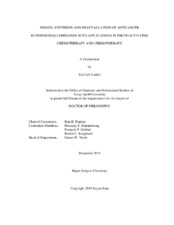| dc.description.abstract | The serendipitous discovery of cisplatin marks a milestone achievement in the field of medicinal inorganic chemistry and spearheaded the development of anticancer metallotherapeutics. Ruthenium (Ru) compounds hold great promise as a potential alternative to platinum (Pt) drugs with improved therapeutic efficacy and different anticancer mechanisms in addition to reduced dose-limiting side-effects. Several Ru metallodrugs are being investigated in clinical trials for their potential to treat cancer malignancies and to stop solid tumor metastasis. Photodynamic therapy (PDT) is an alternative to traditional cancer chemotherapy with more localizing in action. In this modality, a photosensitizer is irradiated with visible light to generate toxic singlet oxygen ( 1O2) inside the cellular environment leading to irreversible cell death. To circumvent the oxygen dependence, a new promising field of therapeutics is under development referred to as photoactivated chemotherapy (PCT) in which a pro-drug, when irradiated with light, induces cytotoxic behavior by releasing caged toxins. Ru(II) complexes that exhibit visible light accessible excited states are increasingly being pursued as photocaging motifs in PCT. In an effort to expand the Ru(II) photocage architecture, a new class of partially solvated dinuclear Ru(II) complexes was developed in which two metal centers are bridged by pyrazine and quinoxaline-based ligands which enhance their absorption in the lower energies of the visible spectrum and near-infrared region which is in the therapeutic window (600-900 nm) for applications as PCT agents. The bridged compounds exhibit moderate photodissociation ability but no phototoxicity properties were detected with visible light irradiation, a fact attributed to high positive charge (+4) and low solubility in the media. To reduce overall positive charge and improve photodissociation, a mononuclear Ru(II) photocage architecture with an unusual bidentate coordination mode of 6-phenyl-2,2ʹ-bipyridine (pbpy) ligand was explored wherein the phenyl ring is directed towards the Ru center to exert steric strain thus enhancing caged ligand dissociation upon irradiation. In fact, this coordination motif generates enough steric congestion to facilitate the dissociation of the caged ligand even in absence of light and as a consequence, is able to covalently bind to DNA and potentially damage the DNA helical structure at higher concentrations.
Finally, to investigate the enhancement of cytotoxic behavior due to cyclometallation, a new series of organometallic Ru(II) compounds was developed with the pbpy ligand and their lipophilicities carefully tuned by choosing suitable ancillary ligand environments that immensely alter their anticancer efficacy. All four compounds are highly toxic against human lung adenocarcinoma (A549) cells with sub-micromolar LC50 values and induce apoptosis via the mitochondrial dysfunctional pathway to trigger programmed cell death upon activation of caspase3/7. It was discovered that intracellular ROS generation partially facilitates cell death through ROS mediated apoptosis. Overall, the research reported in this dissertation constitutes the successful establishment of new avenues into Ru-based anticancer drug design for potential applications in PCT and chemotherapy. | en |


